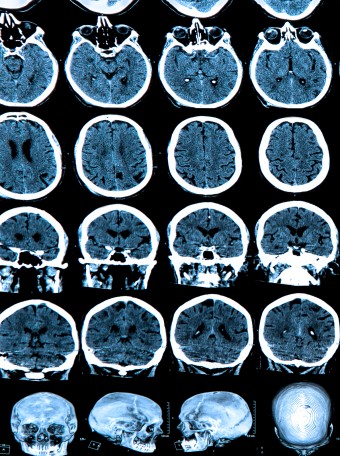Elsie Nicks and Akinetic Mutism
Immobile and silent, those who suffer from the severest forms of akinetic mutism either lack the ability or the will to move or to speak. Caused by any of a number of conditions, diseases and injuries, under certain circumstances the disorder can be treated. One of the most remarkable stories of recovery from this devastating condition happened in 1941, when an Australian-born, Oxford neurosurgeon manhandled a brain cyst and restored a 14-year-old girl to an active life.
Obviously neurological in nature, the disorder is similar to locked-in syndrome, although with akinetic mutism, while the lights are on (the eyes are open and sometimes track movement), there doesn’t appear to be anybody home (evidence of consciousness is minimal at best).
Known causes of the condition include an injury to the frontal lobe, certain types of strokes, encephalitis lethargica, hydrocephalus, Creutzfeldt-Jakob Disease, some aneurysms and tumors, and, notably for this story, a cyst in the third ventricle.
The brain is protected and supplied with cerebral spinal fluid by its ventricular system (comprised of four cavities). One of these cavities, the third ventricle, lies deep within the brain in between the two halves of the thalamus, a portion of the brain involved in transmitting both motor and sensory signals, and that plays a part in the regulation of sleep, consciousness and alertness.
In 1941, Hugh Cairns, a neurosurgery pioneer who had already made a name for himself when he convinced the British Army to make motorcycle helmets mandatory, developed an interest in akinetic mutism, and in particular, the case of Elsie Nicks.
Her entire life, Elsie had suffered from such awful headaches that they had to be treated with morphine. As she entered adolescence, Elsie began to display a series of increasingly odd, and serious, symptoms including drowsiness, apathy, the frequently the appearance of being awake without any conscious awareness, and only occasionally speaking – and that limited to rare “whispered monosyllables.”
Knowing Elsie suffered from a craniopharyngiomatous cyst that was pressing on the posterior medial-ventral surface of her frontal lobe, as well as the walls of the third ventricle, Cairns proposed to ease the pressure by draining the cyst. After the first procedure, Elsie improved for a while and, interestingly, had no memory of her lapse. Unfortunately, as the cyst filled again, her symptoms returned. The draining procedure was repeated twice, and each time, she improved, and then relapsed into her former state of appearing awake, but with minimal consciousness.
Hoping for a more permanent solution, Cairns removed the cyst. Although Elsie showed little improvement immediately after the surgery, within 8 months, she no longer suffered from headaches nor had any symptoms of mutism. Many others with akinetic mutism, of course, are not so lucky.
If you liked this article, you might also enjoy our new popular podcast, The BrainFood Show (iTunes, Spotify, Google Play Music, Feed), as well as:
- Exploding Head Syndrome
- The Mysterious Encephalitis Lethargica Epidemic
- The Curious Case of Alien Hand Syndrome
- The Bizarre Tale of Phineas Gage
- The Curious Practice of Trepanning
Bonus Facts:
- Sir Hugh Cairns led an interesting and productive life. Born in South Australia in 1896, he served in the Australian Army during World War I and was commissioned into its Medical Corps in 1917. He went to Oxford as a Rhodes scholar in 1919, became a member and fellow of the Royal College of Surgeons in 1921, and by 1933, he had taken up neurosurgery. He entered into the order of the Knights Commander (KBE) in 1946. In May 1935, Sir Hugh was one of several doctors called in to attend to T.E. Lawrence (Lawrence of Arabia), who had suffered a traumatic head injury as a result of a motorcycle accident. Lawrence had been travelling (according to police) at nearly 100 mph on his Brough Superior motorcycle when, just as he came over a rise, he swerved to avoid hitting two boys on bicycles. Lawrence died within six days, but the tragedy inspired Sir Hugh to study the impact and life-saving effects of helmets (and their lack) in motorcycle accidents; this research led to the aforementioned 1941 Army mandate.
- Not everyone is convinced Lawrence’s death was an accident. According to one of his biographers (Desmond Stewart) and a local historian (Rodney Legg), several witnesses supposedly saw a mysterious black car run Lawrence off of the road. By one account, the two boys were said to have been kept “incommunicado” and were never called to testify at the subsequent inquest, although another version of the story holds that they had no memory of a car. In any event, a third witness, Corporal (or Private) Catchpole, apparently reported the black car during his testimony, and, according to one source, shortly afterward, he was reported to have committed suicide. Those who adhere to the murder theory also claim that Lawrence’s inquest was administered by MI-5 (Britain’s intelligence service) rather than the local police. They argue that Lawrence, who was still a popular war hero in 1935, was killed due to his political leanings and active engagement in the peace movement.
| Share the Knowledge! |
|





